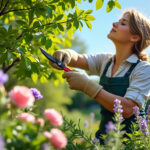Understanding how to properly care for raspberry plants is essential for any gardener striving for a fruitful harvest. The timing for pruning these delightful bushes can significantly influence their growth and fruit production. This guide delves into the critical periods for pruning raspberry plants, highlighting best practices to enhance yield and ensure vibrant health for the plants.
Below is a structured overview of the key sections discussed:
- Types of Raspberry Bushes
- Life Cycle of Raspberry Plants
- When to Prune Raspberry Bushes
- Tools and Techniques for Effective Pruning
- Benefits of Regular Pruning
Types of Raspberry Bushes
Identifying the type of raspberry plant is crucial before attempting any pruning. Raspberry bushes are primarily classified into two categories: summer-bearing and everbearing varieties.
Summer-Bearing Raspberries
Summer-bearing raspberries produce fruit on second-year canes, classified as floricanes. Typically, these varieties yield their harvest in early to mid-summer, providing a concentrated fruiting period over a span of a few weeks. Knowing the right time to prune summer-bearing raspberries not only enhances their growth but also optimizes fruit production.
Everbearing Raspberries
In contrast, everbearing raspberries can bear fruit on both first-year canes, or primocanes, and second-year canes. This unique trait allows for a dual harvest—the first crop occurs in late summer, followed by a second crop in the fall. Understanding how to prune these plants effectively can maximize the yield from both harvests. Regular maintenance aligns with their growth cycles to create robust and productive plants.
| Type of Raspberry | Fruiting Canes | Harvest Timing |
|---|---|---|
| Summer-Bearing | Floricanes (2nd-year) | Early to Mid-Summer |
| Everbearing | Primocanes (1st-year) & Floricanes | Summer & Fall |
Life Cycle of Raspberry Plants
The life cycle of raspberry plants includes several distinct stages that are crucial for proper care and timely pruning. Understanding these stages aids in recognizing the optimal times for intervention.
Dormant Phase
During the winter months, raspberry bushes enter a dormant phase, during which they are less active. This period is ideal for pruning since the plants are not actively growing. Dead or damaged canes can be effectively removed without causing harm to the bush.
Spring Growth
As temperatures rise in spring, raspberry plants begin to sprout new shoots from buds along the cane. This stage is crucial for assessing plant health and planning necessary pruning interventions. Ensuring proper care during this growth phase will set the foundation for a fruitful season.
Flowering and Fruiting
By late spring or early summer, raspberry bushes bloom with delicate white flowers that will eventually develop into ripe berries. During this time, effective nurturing practices ensure healthy fruit development. Monitoring conditions during this phase is key to maximizing yield.
Post-Harvest Maintenance
After the berry harvest, it remains essential to continue caring for the bushes. This includes cutting away old canes that have borne fruit and making room for new growth, thereby promoting a strong yield for the following season.
When to Prune Raspberry Bushes
Knowing the right timeline for pruning raspberry bushes is critical for their health and productivity. This section explores the recommended pruning schedules for both summer-bearing and everbearing varieties.
Pruning Summer-Bearing Raspberries
For summer-bearing varieties, the ideal time to prune is in late winter or early spring, just before the emergence of new growth. This timeframe allows for the removal of undesirable canes while ensuring that the later growth remains strong and productive.
- Remove dead and damaged canes at ground level.
- Thin out crowded canes to enhance airflow and sunlight exposure.
- Target about 4-6 canes per foot for optimal growth.
Pruning Fall-Bearing Raspberries
Fall-bearing raspberries require different pruning strategies depending on desired harvest outcomes. For a single fall crop, canes should be pruned back to the ground after fruiting. Alternatively, for a dual crop option, only the canes that bore fruit in fall can be cut, leaving new primocanes intact for the next harvest season.
- For one crop: Cut all canes to the ground post-harvest.
- For two crops: Remove only the harvested canes, leaving room for new growth.
Pruning Everbearing Raspberries
Everbearing raspberries offer flexibility and can be pruned for both summer and fall harvests. In early spring, it is recommended to cut back the canes by half to encourage growth for summer fruiting. Following the summer harvest, fruited canes should be removed at ground level, allowing fresh primocanes to develop for fall crops.
Tools and Techniques for Effective Pruning
Equipping oneself with the right tools is paramount for effective pruning procedures. Utilizing suitable equipment facilitates a more efficient pruning process and minimizes damage to the raspberry plants.
Essential Tools
Key tools for effective raspberry pruning include:
- Pruning Shears: Sharp shears are vital for making clean cuts without damaging the canes.
- Loppers: Necessary for thicker branches that require more force to cut through.
- Gloves: Protect hands from the thorns of the raspberry canes.
- Safety Glasses: Recommended to shield eyes from any flying debris during pruning.
Pruning Techniques
Follow these techniques for a successful and efficient pruning process:
- Remove Dead Canes: Start by eliminating any dead or diseased canes at ground level.
- Thin Out Crowded Canes: Maintain approximately four to five robust canes per foot.
- Trim Side Shoots: Manage side shoots to encourage stronger growth.
- Cut Back Primocanes: For everbearing varieties, trim back first-year growth in late winter or early spring.
| Tool | Purpose | Recommended Brand |
|---|---|---|
| Pruning Shears | Precise cuts for healthy plants | Fiskars |
| Loppers | Cut thick canes with ease | Corona |
| Gloves | Protect hands from thorns | Gardeners Supply Company |
| Safety Glasses | Protect eyes while pruning | Black & Decker |
When to prune rhododendrons for optimal growth?
Benefits of Regular Pruning
Regularly pruning raspberry plants not only enhances plant health but also ensures robust yields. The practice comes with multiple benefits that are crucial for effective raspberry cultivation.
Healthier Plants and Better Yields
Regular pruning allows raspberry plants to focus energy on producing healthy, vigorous growth. By removing dead or diseased canes, the plant can direct nutrients effectively towards viable branches, resulting in larger, sweeter berries.
Improved Air Circulation and Disease Prevention
Effective pruning enhances airflow within the plant. Reducing humidity levels lowers the risk of fungal diseases, creating optimal conditions for healthy fruit production. Thinning crowded canes not only promotes better light distribution but also mitigates mold and mildew risks.
| Benefit | Description |
|---|---|
| Healthier Growth | Reduces competition for nutrients among canes. |
| Higher Yields | Maximizes productivity from selected canes. |
| Disease Resistance | Minimizes the likelihood of diseases spreading. |
| Better Airflow | Ensures optimal growing conditions for all canes. |
Frequently Asked Questions
- What types of raspberry bushes require different pruning techniques?
Summer-bearing and everbearing raspberries need distinct pruning methods due to their differing fruiting patterns. - When is the best time to prune raspberry bushes?
The optimal time to prune is during the dormant phase, typically in late winter or early spring before new growth starts. - How does pruning affect the fruit production of raspberry plants?
Pruning stimulates fresh growth and maximizes yield by ensuring that energy is focused on the healthiest canes. - What tools are essential for pruning raspberries?
Essential tools include pruning shears, loppers, gloves, and safety glasses to ensure safety and precision during the process. - Can pruning be done at any time of the year?
It is generally best to prune in late winter or early spring, as pruning during the growth season can hinder the plant’s development.








